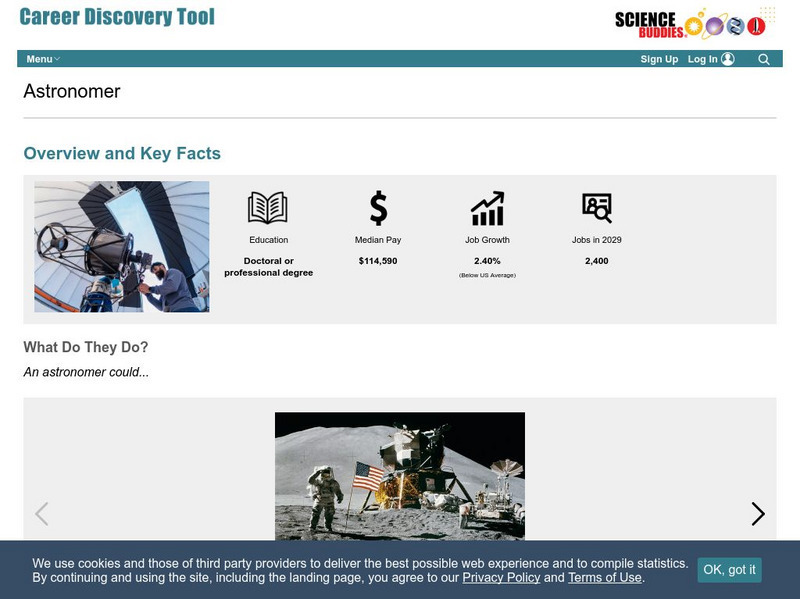Hi, what do you want to do?
Curated OER
Super Scientists Code
In this science worksheet, students use the key code on the right to unscramble each of the scientists. They also match each of the scientists found to their correct description.
Curated OER
Solar System
For this Solar System worksheet, 5th graders demonstrate knowledge of parts of the Solar System. Students unscramble letters to list these parts.
Curated OER
Doing Science: Computer Models
In this computer models worksheet, students read information about how scientists use computer models to advance the work of science. Students also answer a critical thinking question comparing computer simulations to direct observations.
Curated OER
Modeling Celestial Motion
In this modeling celestial motion worksheet, learners fill in the blank about the motion of celestial bodies: planets and stars. Students complete the blanks with information about the scientists and philosophers responsible for early...
Curated OER
Measuring Temperature: Celsius
In this measuring temperature, Celsius, worksheet, students study, analyze and discuss how temperature tells us how hot or cold something is. Students measure the Celsius degrees of five temperatures.
Curated OER
Radiation from Space
In this radiation worksheet, students review the different types of radiation waves that come from space and the different telescopes used to detect this radiation. This worksheet has 17 true or false questions.
Curated OER
Star Magnitudes
In this stars worksheet, students use a chart comparing the absolute and apparent magnitudes for different stars to complete 4 fill in the blank and 2 short answer questions.
Curated OER
Intermediate Sentence Completion 8
In this sentence completion worksheet, learners read the sentences and choose the best word to complete the sentence. Students complete 12 sentences.
Curated OER
Gamma Ray Bursts
Students study an article on Gamma Rays. For this investigative lesson students study the energy and wavelengths of gamma rays and the theories behind them.
Curated OER
Using Parallax to Determine Distances
Students study parallax and what it is used for. In this distance activity students complete an activity that allows students to get experience using a parallax.
Curated OER
A Star Party
Students explore the parts and function of a telescope. In this investigative lesson students gain an understanding of a telescope and identify planets and constellations.
Curated OER
Who Am I? Famous Scientists
In this scientists worksheet, learners read a brief synopsis of a scientist, then try to identify the person, 12 total. Worksheet contains links to additional activities.
Curated OER
Sun too close? We'll just change Earth's orbit
Students study an article and discuss what would happen if the Earth's orbit changed. In this Earth's orbit instructional activity students answer a list of questions and complete an activity.
Curated OER
Gerunds and Infinitives 12
In this gerund and infinitive worksheet, students complete a set of 10 multiple choice questions, choosing the correct answer and clicking on a "check" button for immediate feedback.
Curated OER
Measuring the Sun's Diameter
Students project and measure the suns image using a refracting telescope. In this sun's diameter lesson students calculate the magnification of the telescope and determine the diameter if the Sun.
Curated OER
Spectroscopy Demonstrations
Students study light and see what emits photons and that light can be separated onto a spectrum. For this energy and matter lesson students identify gases using a spectrum chart.
Curated OER
Lives of Stars
Students take notes on the lives of stars. In this lesson on stars, students take notes alongside a PowerPoint presentation about the lives of stars.
Curated OER
How Did the First Asteroid Come to be Discovered?
Pupils examine asteroids including how and when they were discovered. In this asteroid lesson students view a PowerPoint presentation on asteroids.
Curated OER
Lives of Stars
Students explain in their own words how stars are formed. In this space science lesson, students summarize the life cycle of stars. They draw diagrams and label the step of the cycle they represent.
Curated OER
Soil Comparison and Analysis
Students perform tests on different soil samples. In this earth science lesson, students classify the soil into groups according to test results. They write a lab report following a certain criteria.
Curated OER
Measuring the Speed of Light
Young scholars explore physics by completing measurement problems in class. In this speed of light instructional activity, students discuss the importance of knowing the speed of light and how it affects many aspects of human life on...
Curated OER
Space Facts
Students read space facts and click on the links to research more about space objects. In this space lesson plan, students read about comets, planets, the moon, and more.
Curated OER
Scientific Theories
Ninth graders compare and contrast how different models can be used to represent scientific understandings. They evaluate the use of data when considering scientific claims. Students debate a variety of socio-scientific issues and the...
Science Buddies
Science Buddies: Career Profile: Astronomer
Reach for the stars by checking into the career as an astronomer. This Science Buddies site lays out the requirements needed to become an astronomer, as well as the education and job description. Included are interviews with people who...
Other popular searches
- Famous Astronomers
- Early Astronomers
- Major Astronomers
- Ancient Astronomers
- Greek Astronomers
- Report on Astronomers
- Astronomers Measure Distance
- Women Astronomers
- Female Astronomers
- Fumes Astronomers
- Five Early Astronomers
- Famous Astronomers Quizes




























